Introduction
Environmental conservation is one of the main issues affecting the modern global society. Environmental scientists have warned against global warming and other serious consequences of environmental conservation.
According to Liu et al. (2018), one of the major areas of concern in environmental conservation is the massive generation of electronic wastes. The growing popularity of mobile phones, television sets, computers, and other electronic products means that a significant amount of these wastes is produced every year. One of the countries that produce a massive amount of electronic wastes in China. Unlike the biodegradable wastes, components of electronic wastes such as plastic wastes and metals may have lasting environmental consequences. As Namias (2013) observes, it is expected that China will continue producing more electronic wastes within the coming years. It is important to find ways of managing these wastes responsibly.
Aim and Objectives
The primary aim of this project is to investigate the current electronic waste management practices in China and propose effective approaches that the country can embrace to deal with the problem. The study will propose ways in which the country can deal with the issue of the ever-increasing generation of this form of waste. The following are the objectives that had to be achieved by the end of the study.
- To identify current electronic waste management practices in China;
- To determine weaknesses in the current waste management practices in China;
- To propose environmentally responsible ways that the country can embrace to deal with the problem of electronic waste generation.
Demographics
The amount of waste that a country generates, as Williams (2016) observes, directly relates to the size of its population. It is estimated that the current population of China is over 1.4 billion people, which accounts for one-fifth of the world’s total population (Williams 2016). The majority of the population (over 90%) are the Han ethnic group. The Zhuang forms a significant minority (7.13%). Other ethnic groups account for about 1% of the entire population of the country (Khan & Chang 2018). Figure 1 below summarises the ethnic composition of the Chinese population.
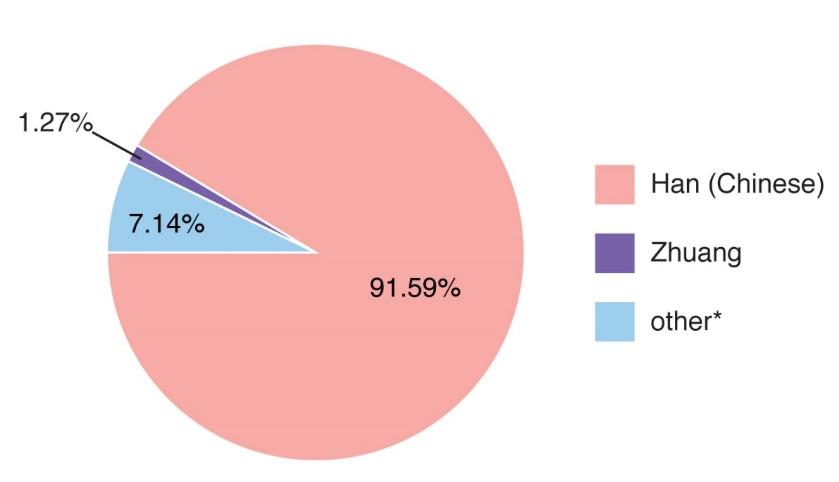
Problem Identification
Recent scientific studies show that the earth may not withstand the massive pollution that has been going on for the last several decades shortly. The impact of environmental degradation is already being experienced in various parts of the world. The frequent cyclones in Asia, disastrous wildfires in North America and Europe, and prolonged drought in African are indications that the pressure exerted on nature by various pollutants is too great to bear.
One of the countries which are worst affected by this problem is China. According to Washburn (2013), major industrial cities such as Shanghai have had to bear a high level of air pollutants that infants and the elderly people have to remain indoors at specific hours of the day to avoid respiratory diseases.
If the current trends continue, some of these Chinese cities will be inhabitable. The goal of economic growth and development is to make life easier and better for the citizens of a given country. Such a goal will be lost if people are forced to leave their homes because of the high levels of contamination of the air. The country’s economic progress will ultimately be meaningless.
Electronic waste is one of the most common sources of pollutants in China. According to Yamamoto and Hosoda (2016), almost every resident in China (over 1.4 billion people) use some form of electronic gadget. It may be an electronic toy that is very popular with children; phones, tablets, or personal computers popular among youths and adults; and television sets popular among the elderly. In the end, these products become wastes that have to be disposed of.
Every time a new model of a phone or computer emerges, people rush to dispose of the old models in favor of the new arrivals. It means that in some cases these electronic products are disposed of even before they complete their lifespan. With such a massive population, it is a major cause of concern that the country produces such a significant amount of waste. Components of these wastes such as plastic and specific metals pose a serious threat to the environment. Yamamoto and Hosoda (2016) warn that if these wastes are not managed properly, the country may face serious environmental consequences. The project seeks to find ways in which this country can deal with the problem before it becomes too overwhelming to overcome.
Methodology
When conducting research, it is necessary to develop a plan that defines how data will be collected and analyzed. The limited-time available for this project made it difficult to collect data from primary sources. As such, the researcher opted to conduct desk research. This approach involves using online libraries and platforms to collect secondary data needed for the study. Information about the management of electronic waste is readily available in books, articles, and other online platforms. The method was chosen because it is simple, cost-effective, and less time-consuming. The goal was to ensure that information collected from these sources was able to address the aim and objectives of the study.
Economy
Gross Domestic Product (GDP)
When analyzing the number of electronic wastes that a country produces, one of the factors that cannot be ignored is the gross domestic product. China has the second-largest GDP in the world, second only to that of the United States. As shown in figure 2 below, the GDP of this country has been growing consistently over the past ten years, and Veit and Bernardes (2015) project that it will surpass that of the United States in a few years to come. The growth has been stimulated by the massive manufacturing industry and the export of these products to the international market. As Gardner (2018) observes, the larger the GDP, the greater the generation of electronic waste, especially in a country that has a huge population.
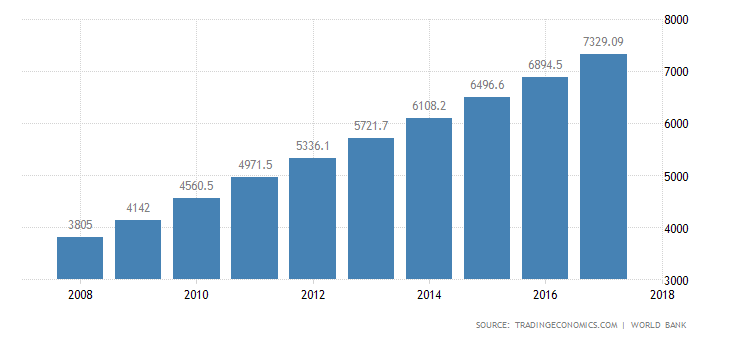
Gross Domestic Product (GDP) Growth Rate
It is important to look at the growth rate of the GDP because it also defines how much the country is projected to use electronic resources. According to Veit and Bernardes (2015), China has one of the highest GDP growth rates of all the developed economies.
As shown in figure 3 below, in 2010 when the United States, Europe, and other economies around the world were affected by the recession, Chinese GDP was growing at double digits (10.16%) (Veit & Bernardes 2015). Although the growth rate has slowed consistently since then, partly because of the huge size of the economy, it is still experiencing impressive growth compared with other developed nations. It is an indication that electronic waste generation is likely to become a major problem in this country in the coming future.
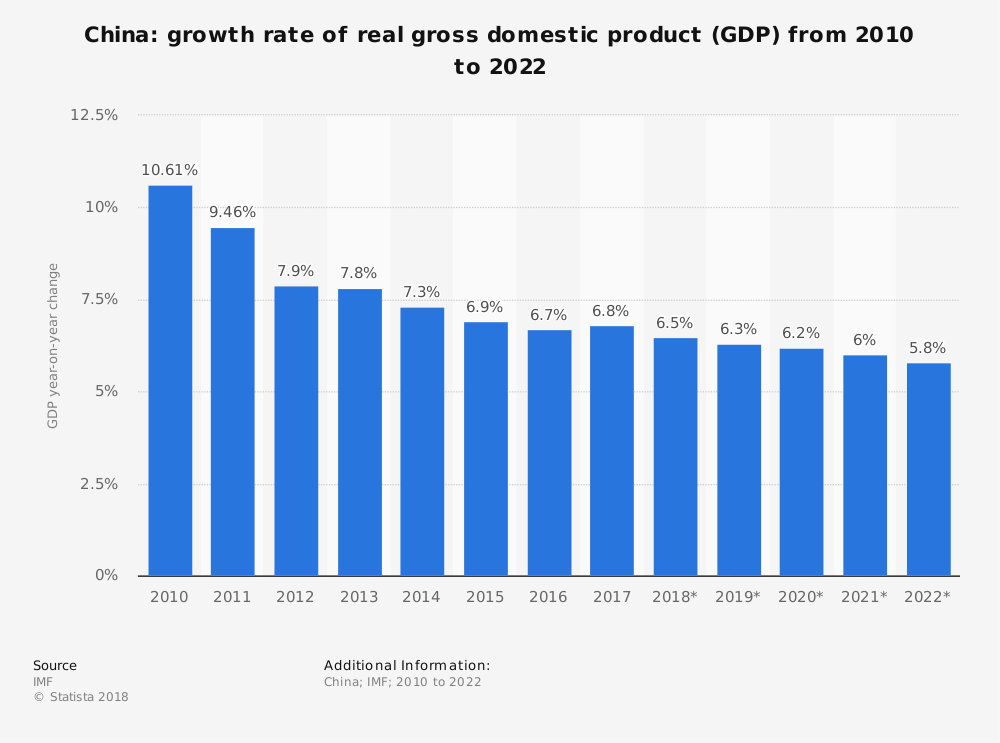
Major Sources of Income
A critical analysis of major sources of income in a country can also help in determining the rate at which electronic wastes are generated. As Sternfeld (2017) explains, countries that rely on agricultural-based income sources tend to generate less electronic wastes than those that emphasize manufacturing. China is currently the leading manufacturer of various electronic products, outpacing the United States and Japan. The following are the main sources of income in China.
Manufacturing
Manufacturing is the primary source of income in China. After many years of the economic revolution, the Chinese government came up with ways of promoting its manufacturing sector. It lowered its energy cost, improved skills of the local human resource, and created a huge market both locally and internationally for these products. The ability of the country to produce cheap products for developing states has enabled it to dominate the African market (Veit & Bernardes 2015). The country also exports these manufactured products to North America, Europe, and other parts of Asia-Pacific.
Services
The service industry has also been growing rapidly over the years. The banking sector, entertainment, and education are some of the main service industries, which have registered impressive growth over the recent past (Sternfeld 2017). These sectors rely on various electronic products. Schools are currently using iPads and computers to make learning easier than it was in the past. Entertainment in modern society is purely based on different electronic gadgets.
Banks and microfinance institutions have to use computers to facilitate their operations. Al-Habaibeh, Meyerowitz, and Athresh (2015) explain that the emerging technology-based trends are likely to promote the use of electronic products. Figure 4 below shows how the education sector is becoming increasingly reliant on electronic gadgets to disseminate knowledge.

Agriculture
The Chinese economic revolution did not only focus on the industrial sector but also on agriculture. It was necessary to ensure that the country could feed its 1.4 billion people. According to Al-Habaibeh, Meyerowitz, and Athresh (2015), the Chinese agricultural sector employs more than 300 million people who use modern technology to improve yield. It is the world’s top producer of agricultural produce, with wheat, rice, soybeans, peanuts, tea, sorghum, cotton, and barley being some of the main crops. The agricultural sector is capable of meeting the local needs and export excess to the international market.
Poverty Rate
The rate of poverty is also relevant when investigating the problem of electronic waste production. According to Sternfeld (2017), the rate of poverty in China has been on a downward trend since the 1980s. Rural dwellers are relatively poorer than those living in major urban centers are. However, statistics in figure 5 below show that living standards for both rural and urban dwellers are improving. It means that more people can now afford to use multiple electronic gadgets such as phones, tablets, and personal computers. It is an indication that the amount of electronic waste generation is likely to increase in the coming future.
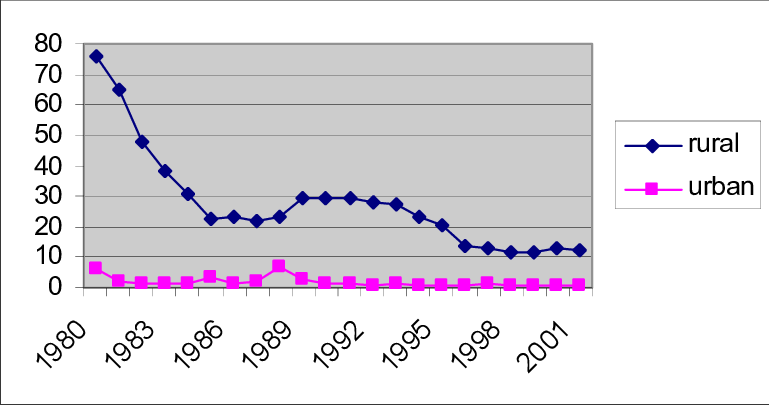
Human Development Index
According to Yamamoto and Hosoda (2016), the human development index is a composite of life expectancy, per capita income, and education. These three defining factors of HDI are affected by the level of wealth that a country has. Sternfeld (2017) notes that although Chinese HDI is relatively below that of most of the developed economies (ranked 65th in the world), it has been improving steadily over the past decades.
Its education system has improved significantly, as it embraces the emerging concepts and new technologies. The per capita income has also been increasing relative to the country’s GDP growth. Life expectancy has also increased as the government improves the health sector and people embrace healthy lifestyles. Figure 6 below shows the decreasing mortality rate in China from 1970 to 2015.
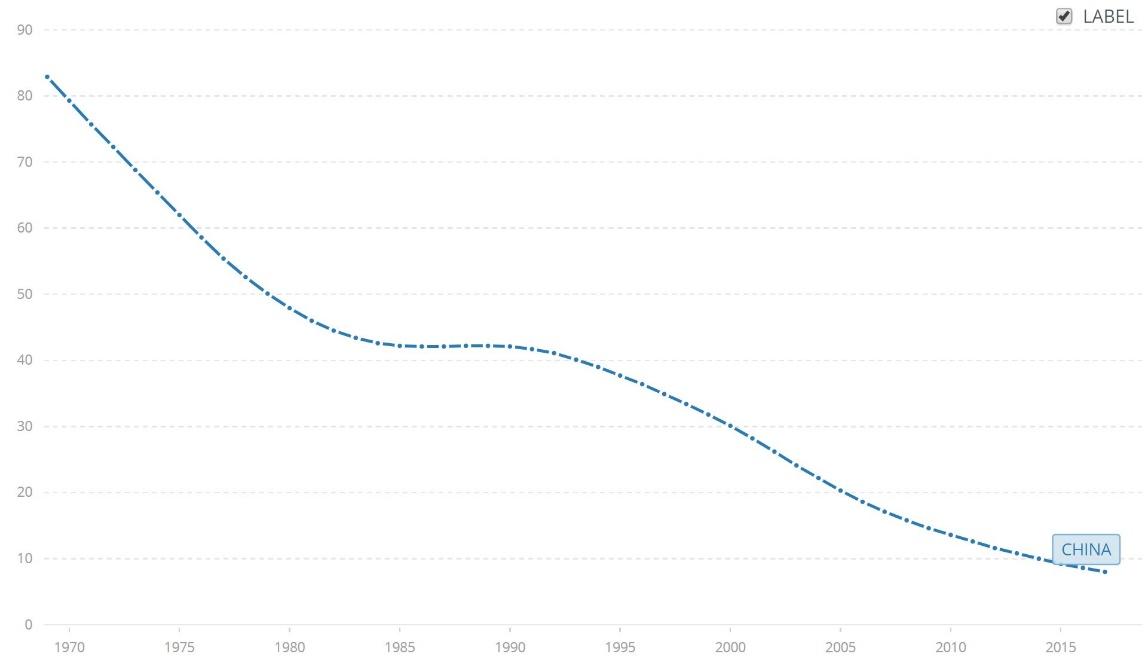
Resources
Managing wastes is one of the challenges that many countries around the world face in modern society. People must earn their living and in so doing, it is not possible to avoid the generation of waste. A critical analysis of resources available within a country can help in defining how they can be tapped in a way that generates the least possible pollution. One of the biggest resources that China has over any other nation in the world is human labor. According to Yamamoto and Hosoda (2016), the Chinese labor force (people who are involved in income-generating activities) was estimated to be over 776 million people. The number will increase. The following resources are important when focusing on waste management.
Water Sources
China has an adequate supply of water in most parts of its territories. Some of the main rivers that supply water for domestic, industrial, and agricultural use include the Pearl River, Yellow River, Yangtze River, Huai River, and Liaohe River (Amjad et al. 2015).
Some of these rivers have poor water quality because of pollution. The effluents from major industries in the country and irresponsible disposal of various forms of waste have led to the pollution of these major rivers. However, the effort put in place by the government and various environmental agencies has helped in reducing the number of pollutants getting into these water sources. Songhua River, which was classified as moderately polluted, has improved its status to slightly-pollute because of these efforts to control the number of wastes released into water sources.
Energy Sources
The massive population and rapidly expanding industrial sector has transformed China into one of the leading consumers of energy. It is currently the second leading importer of oil and gas to facilitate normal operations in the industrial sector (Anttila & Boffetta 2014). Although petroleum products are still important sources of energy, the country has taken bold steps to increase its production and consumption of renewable energy.
Wind and solar energy are becoming popular in the domestic and industrial sectors. The government has given tax incentives to companies specializing in the production of these renewable energy sources. Geothermal and hydroelectric power sources are also critical in providing the energy that the country needs. Yamamoto and Hosoda (2016) explain that China has also taken impressive steps in promoting the production and use of biomass for domestic use.
Electronic Waste
In the previous sections, the researcher has provided a detailed overview of the Chinese economy, its population, resources, and factors that may be linked directly to the problem of e-waste generation. In this section, the focus is on providing a detailed definition of e-waste, its generation, components, and the current approach that local stakeholders use to manage it, and appropriate methods that should be embraced based on the emerging trends.
Definition
Electronic waste, also known as e-waste, has been defined by different entities in different ways. Yamamoto and Hosoda (2016, p. 78) on the other hand defines it as “discarded appliances using electricity, which includes a wide range of e-products from large household devices such as refrigerators, air conditioners, cell phones, personal stereos and consumer electronics to computers which have been discarded by their users.”
Gardner (2018, p. 56) on the other hand defines electronic waste as “any refuse created by discarded electronic devices and components as well as substances involved in their manufacture or use.” Although scholars and environmental conservationists are yet to develop a standard definition for electronic waste, there is an agreement that the term refers to discarded electronic products. They may or may not be recyclable depending on several factors.
Table 2 below identifies how the term electronic waste has been defined by different entities over time. Electronic products have become critical in modern society. From school to home and in the industrial sector, different electronic products play different roles in society. At home, television sets, mobile phones, music systems, fridges, microwaves, and related gadgets are instrumental in normal daily life. At school, computers and iPads have become essential tools of learning. Large companies rely on computers to process, store, and share data when it is necessary. These instruments have to be discarded at the end of their lifespan. When they are disposed of, they become electronic waste.
Gardner (2018) explains that electronic waste goes beyond the specific electronic instrument that a person discards. It also includes packages and casing of these instruments. It means that when a person discards an old computer that is no longer operational or is ineffective because of the emergence of new more efficient models, the entire system is considered electronic waste. Steven (2014) argues that there has been a misleading argument that electronic waste only refers to the electric component of the equipment.
Classifying the entire system as electronic waste makes it easy to determine how to dispose of each component. It is important to note that plastic materials used in some parts of a computer system are significantly different from the plastics used to make chairs or bottles. The approach used in their disposal may be different. As such, understanding the proper definition of electronic waste is critical.
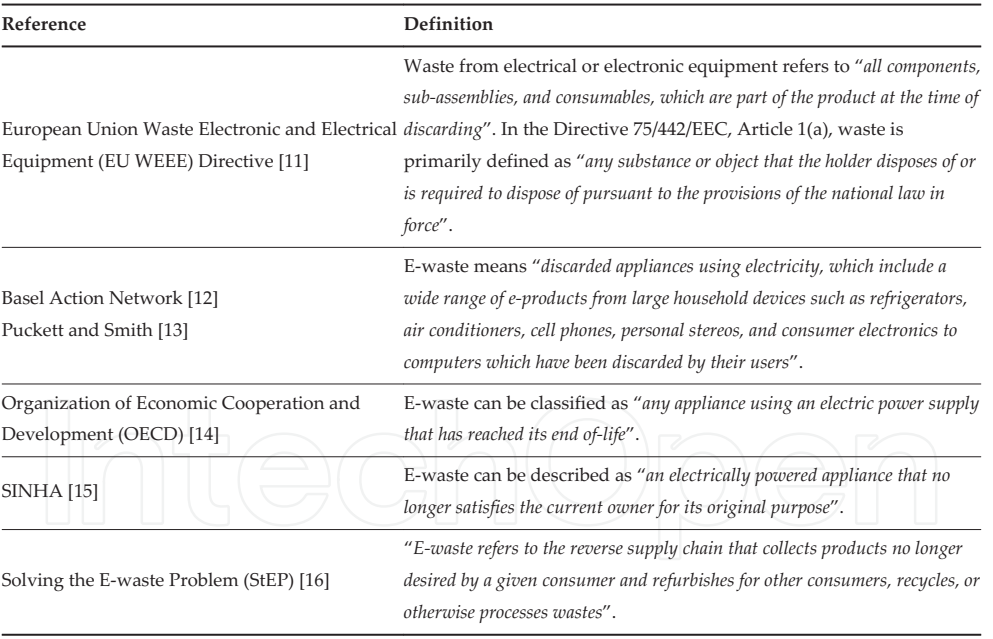
Electronic Waste Generation
Electronic waste, as shown in its definition, is generated when an electronic gadget is disposed of. Although most of these wastes come from old products that can no longer be in use, sometimes people discard functional products because of the emergence of new ones considered more fashionable (Anttila & Boffetta 2014). An individual can discard an iPhone 6s because iPhone X is considered more fashionable. Throwing away from less fashionable items is a common practice among the rich or in cases where one cannot sell or donate the old equipment. Whether it was functional or not at the time of disposal, the gadget becomes e-waste.
Sources. The electronic wastes come from various sources. One of the most common sources of electronic waste is discarded home electronic appliances. According to Gardner (2018), home appliances account for a significant portion of electronic waste generated in China and the rest of the world. It may be an old iron box, microwave, television set, a music system, or mobile phones. Once these items cease to be of meaning to the owners, they end up in dumping sites.
Another major source of electronic waste is the industrial sector. Companies are under pressure to embrace the use of technology as a way of improving their products in the market. In most cases, they have to replace computers they use periodically, especially when a new better generation emerges.
Traditionally, such old and less efficient computers would be donated to African and other less-developed nations at a small fee (Anttila & Boffetta 2014). However, these nations are no longer interested in the old electronic products. Their leaders are aware of this dumping strategy and restrict the types of electronic products that they allow into their country. It means that some of these computers have to be sent to the dumpsites once they are considered irrelevant to the companies.
Educational institutions and other government entities are also responsible for the production of electronic wastes. Each year, millions of tones of electronic wastes are generated and it is not yet clear to many countries around the world how it should be managed. The unique components of these wastes make it necessary to avoid some of the conventional methods of processing wastes.
Composition. The composition of an electronic waste varies depending on the type of the device, its model, date of manufacture, the company that manufactures it, and its age. Some of these components may be useful in the manufacture of various products while others are toxic and require proper management. A product such as a mobile phone has numerous elements. It has metals such as Copper (Cu), Lithium (Li), Tin (Sn), Cobolt (Co), Antimony (Sb), Indium (In), Palladium (Pd), Gold (Au), and Silver (Ag) (Anttila & Boffetta 2014).
It also has plastic and rubber materials. An obsolete freezer, refrigerator, and air conditioners have Chlorofluorocarbons (CFCs), which is a dangerous substance to the ozone layer. It also has barium, copper, lead, cadmium, zinc, and other metals. Figure 7 below identifies the primary composition of electronic wastes. As shown in the figure, different types of metal form the main components of electronic wastes. Pollutants in liquid, gaseous and solid forms are also part of the electronic wastes. Other major components include printed circuit boards, CRT and LCD monitors, metal-plastic mixture, cables, plastics, and other components depending on the nature and model of the product.
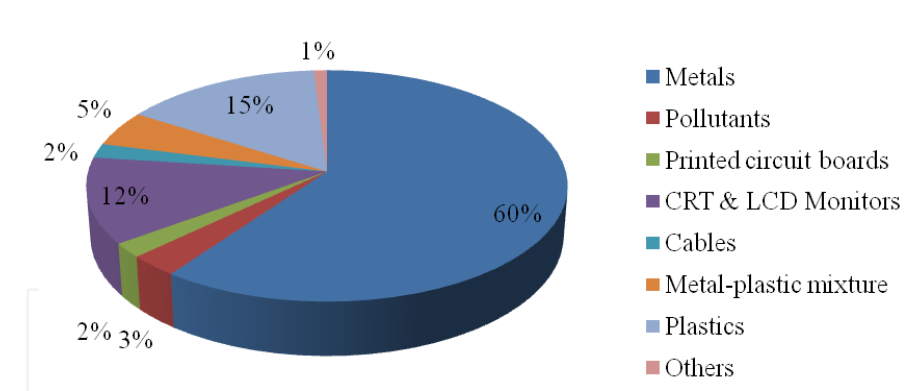
These wastes are often heaped in piles in various dumpsites within the country as they wait for the proper approach of disposal. In the past, it was common to find electronic wastes heaped together with general wastes and dumped in landfills without any regard for the environmental consequences they may have. However, that trend is changing as people become more conscious of the dangers of different components of these wastes. Figure 8 below shows a wide variety of electronic wastes, which are yet to be sorted out for proper disposal.
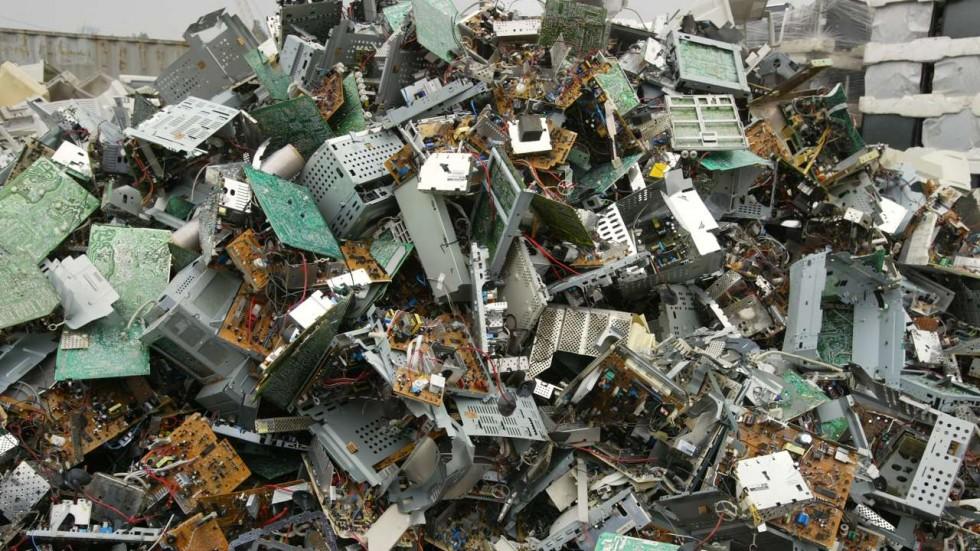
According to Steven (2014), when managing electronic wastes, it is necessary to know the composition of different discarded gadgets. It helps in determining those that pose a serious environmental threat. A television board is primarily composed of silver, copper, gold, and palladium. The percentage weight of copper in this board is 20% (Anttila & Boffetta 2014). A personal computer board has a percentage of 20% copper. It has more silver, gold, and palladium than a television board. The percentage of copper on a mobile phone is 13%. It has the highest ppm of silver than any other board in table 2 below. Portable audio crap has 21% of copper while a DVD player crap has only 5% copper crap.

Understanding these components is critical because some of these metals are recyclable and very important. Gold, silver, and copper are highly precious and expensive metals. They can be recycled for use in making similar products or other items. Gold can be used to make ornaments or as a store of value. Copper is useful in making cables, bullets, and numerous other products. Silver is used in making coins and other items. Instead of dumping such materials in landfills, proper mechanisms can be developed to extract them from the waste so that they can be recycled. It will ease the burden of the waste while at the same time creating value for the individuals involved in waste management.
Seasonal changes
Electronic waste generation and composition from home appliances are not often affected by season. People discard home appliances whenever they feel these items are no longer needed. However, wastes from companies and mobile phones may vary with seasons. Every time a new model of a popular phone is introduced in the market (such as iPhone), people often rush to purchase them (Anttila & Boffetta 2014). In such seasons, there may be a sudden increase in the number of mobile phone wastes. Many companies also consider reviewing and renovating their systems by the end of the year.
Anttila and Boffetta (2014) note that it is common to find cases where the number of electronic wastes such as computers increases nearing the end of December or in early January. Economic booms may also cause an increase in electronic waste. When people can afford to purchase new electronic products, they find it necessary to discard the current one considered less fashionable or less efficient. Conversely, during the recession, electronic waste tends to reduce significantly (Iskyan 2016). People prefer staying with their gadgets for longer even if they are less efficient or out of fashion because they may not afford to purchase new ones. These standard practices have a direct impact on the amount and volume of electronic wastes within the country.
Estimation of electronic waste generation
According to Khan and Chang (2018), some of the developed countries are keen on hiding the true statistics about the number of electronic wastes they generate each year. Some of these countries are using the unconventional approach of dumping such wastes in developing nations. As shown in figure 9 below, China generates the highest amount of electronic wastes in the world. In 2016, it generated over 7.2 million metric tons of electronic wastes, which is estimated to be 5.2 kilograms per capita (Anttila & Boffetta 2014).
The United States came second, generating 6.3 million metric tons of electronic wastes in the same year. Other countries ranked in the top ten in the emission of electronic wastes include Japan, India, Germany, Brazil, Russia, France, Indonesia, and Italy. The most common types of electronic wastes include television sets, mobile phones, computers, and other household electronic appliances.
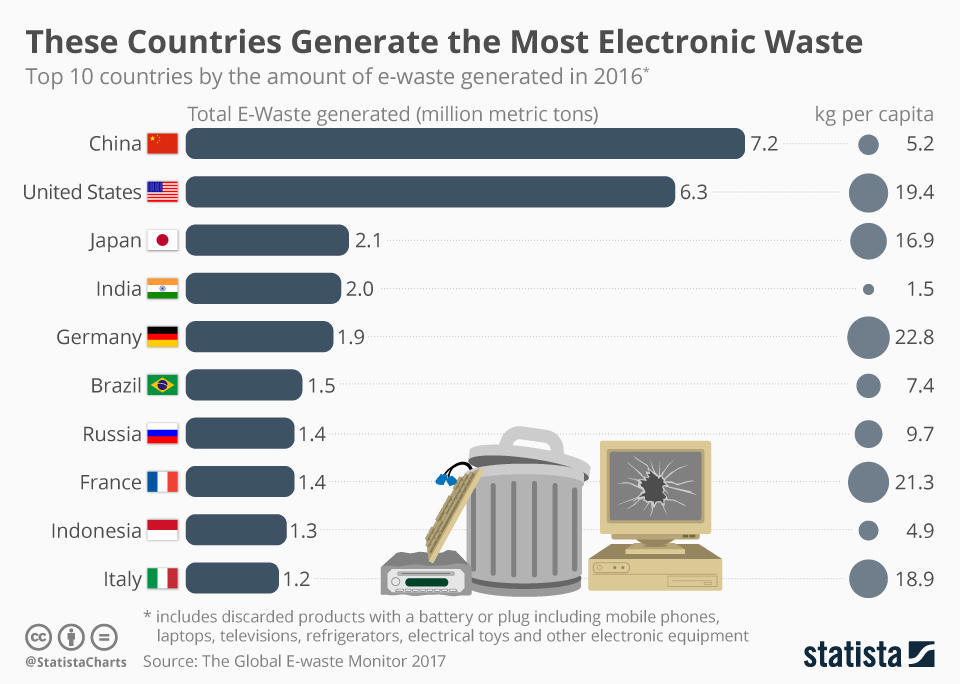
Current Electronic Waste Collection and Disposal
The current approach that is used in the collection of electronic wastes does not conform to the standard practice that has been proposed to help reduce the impact of these products on the environment. According to Al-Habaibeh, Meyerowitz, and Athresh (2015), those who have an interest in electronic wastes are people who understand their value when recycled or reused. These businesspersons are interested in different parts of various electronic products that they know have value. As such, their interest is not to protect the environment but to earn a living from the wastes in what Henkel (2015) defines as waste mining.
It means that if they find electronic wastes that are of little value to their business, they will dispose of it as normal waste, which may be a threat to the environment. Efforts to promote effective management of waste are gaining ground in the country. The Chinese government, working closely with various environmental agencies, has realized that it is necessary to embrace the responsible disposal of electronic wastes. Scientific studies have proven that irresponsible waste disposal may have serious health and environmental consequences (Anttila & Boffetta 2014). The high rate of respiratory diseases in China is a clear indication that measures need to be taken to reduce pollutants in the environment.
Phases of collection
The traditional approach to waste disposal is still common in most parts of China. This approach has several phases. The first phase is the disposal by companies and households in various bins and bags provided by small firms responsible for the collection of waste. Once or twice a week, the companies will come and collect the wastes using trucks. It is important to note that at this initial stage, wastes are yet to be sorted. They are then transported to specific dumpsites where ‘waste miners’ will try to sort out electronic wastes from the rest of the garbage. General waste will be taken to the landfills.
The electronic wastes will be subjected to further sorting. The miners will select all the important parts that can be recycled, reused, or sold in its current form and transport it to their warehouses (Anttila & Boffetta 2014). The other components that are of limited value will be put together with the rest of the other solid wastes destined to the landfills. The stages are based on what is of interest to the individuals mining important materials from the wastes and not the desire to protect the environment. The approach needs to change. Khan and Chang (2018) argue that managing electronic wastes should not be left to the informal sector. The government should establish specific entities to deal with this problem.
Cost of collection
Determining the accurate cost of collection and management of electronic waste in China may not be easy. According to Al-Habaibeh, Meyerowitz, and Athresh (2015), the local authorities in major urban centers often contract specific garbage collection companies to collect and dispose of all wastes without differentiating them into specific classes. It is important to note that wastes in the sewerage system are fully managed by the local authorities and it is out of the scope of this study.
According to Gardner (2018), the local authorities in China signed a contract of over 100 billion yuan ($14.6 billion) with private waste management companies in the country. Individuals working in the garbage collection industry earn 200 RMB (about USD 28.99) in a day, which translates to 67,200 RMB (about USD 9,740.64) in a year.
Gardner (2018) argues that the initiative that has been taken by the government to invest in infrastructure to help recycle wastes is set to reduce the threat posed by electronic wastes. Figure 10 below shows how much the country has been investing in infrastructural development to help promote the recycling of wastes.
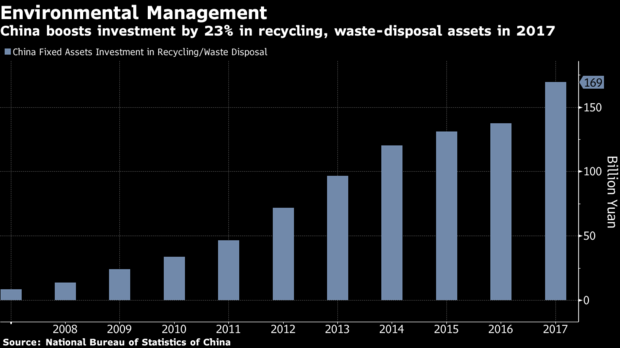
Transportation of electronic waste
When electronic wastes and other general wastes, have been collected from residential, commercial, and industrial estates, they have to be transported to various dumpsites for assortment before they can be taken to the landfills. Large trailers and specialized garbage trucks are used to transport these items to the relevant destination. The local municipal and urban authorities own some of these trucks. Private firms operating in the informal sector also own a significant number of trucks used to transport these wastes. Figure 11 below shows workers loading wastes into a trailer before they can be transported to specific destinations.
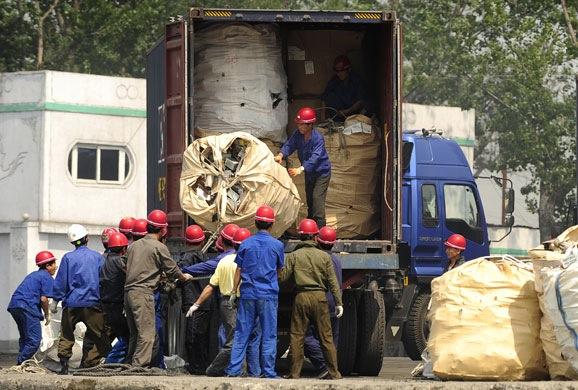
Disposal
The final stage is the disposal. After sorting out the electronic wastes, some components will be considered damaged beyond the stage that they can either be recycled or reused in their current form. Such components must be disposed of because they are no longer in use. China is currently investing in waste treatment. However, the treatment of electronic waste is still rare in the country (Anttila & Boffetta 2014). As such, most of these components end up in the landfills as their final destination. They are often disposed of alongside other wastes that belong to the same class.
Solving the Problem of Electronic Waste
Electronic waste is becoming a major problem not only in China but also to the rest of the world. According to Khan and Chang (2018), China’s problem when it comes to the management of electronic wastes is unique. The generation of electronic wastes is defined by two principal factors. One of these factors is the living standards and the other is the population size. The rich and the middle class are mainly responsible for the generation of electronic wastes. They have the financial capacity to purchase these gadgets and have the desire to do so as a sign of their social class. Currently, about 400 million Chinese belong to the middle class.
The number is expected to increase to about 700 million people by 2022 (Anttila & Boffetta 2014). It means that a huge population in China is becoming economically empowered. People can afford to replace their electronic gadgets regularly, which means that the amount of electric wastes generated is bound to increase. The current strategies used in the management of this type of waste may not be relevant in the coming years. The country may not be able to deal with the massive amounts of wastes, especially from the major urban centers. In this section, the focus will be to look at best practices that can be embraced by the country to help manage electronic wastes.
Collection
Managing electronic wastes starts from the collection stage. Gardner (2018) explains that when proper measures are taken when collecting wastes; it will be easy to deal with electronic wastes at later stages of management. The appropriate method of data collection involves segregating the wastes from the initial stage. Instead of placing all the wastes in one container, there should be containers for a specific group of wastes.
As shown in figure 12 below, there should be a container for plastic wastes, food remains, electronic products, general waste, and paper wastes. Each of these classes would require different approaches to management. In China, it is common to find cases where many people opt to sell their old electronic gadgets to informal businesses. They often have specific locations near residential areas where people can drop these items. It is the best approach for an individual to dispose of these products. If that is not an option because of various reasons, then the electronic waste should be placed in specific containers that meet specific criteria.
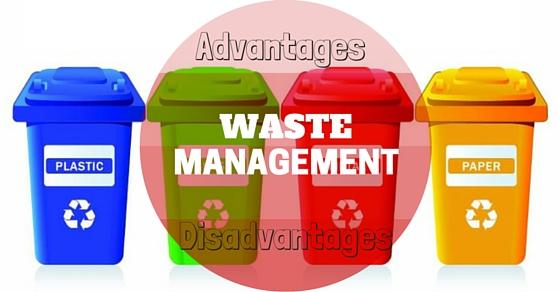
Availing relevant containers and equipment
According to Al-Habaibeh, Meyerowitz, and Athresh (2015), one of the first steps in responsible management of electronic wastes is the provision of the relevant containers and equipment. The local government authorities should ensure that these containers are made available in the residential, industrial, and commercial districts in major urban centers across the country. They should be conveniently located to avoid cases where people have to travel for several kilometers to dispose of their wastes. People are often motivated and become responsible if they have access to means of effective waste disposal. Each container should be marked appropriately, indicating the type of waste that it should hold. Using both words and pictures will help residents to understand where to place their wastes.
Planning
The local government authorities, working closely with the contracted private garbage collection firms, should develop a plan that defines how various activities will be undertaken. The plan should explain individuals who are responsible for specific activities. For instance, it should be stated in clear terms that the local government authorities would be responsible for the provision of containers used in sorting out waste.
The private contractors should inform the government when it is appropriate to either replace or upgrade these containers. During the planning stage, all stakeholders should be involved in determining appropriate ways of disposing of wastes. If some components can be recycled, then a standard practice should be developed that all stakeholders will need to follow when dealing with wastes. Developing such standard practices makes it easy to define innovative ways of dealing with the challenges faced in such processes.
Entities are responsible
The government of China, through the Ministry of Ecology and Environment and local authorities, is responsible for the elimination of all forms of wastes in the country. The principal entity must play a leading role in waste electronic management. Its primary responsibility would include planning, financing, and guiding various processes in e-waste management. Private waste collection firms are other entities responsible for the management of electronic wastes (Anttila & Boffetta 2014). They have the primary responsibility of implementing plans developed by the stakeholders on how to manage electronic waste.
They have to study and embrace best practices. Environmental conservation agencies and scientists are another group of stakeholders that must be involved in electronic waste management. They can provide appropriate advice on how electronic wastes should be managed based on research. Individuals staying in China also have a responsibility to dispose of electronic wastes based on the standard guidelines.
Disposal
When electronic wastes have been collected, the most important phase is its disposal. As explained above, some of these electronic products are often sold to private business entities, which later sell them to individuals or other businesses locally or internationally. Those that should be disposed of locally should follow a clearly defined approach. Recycling of different metals such as copper, gold, and silver components of these electronic products is highly encouraged. The unrecyclable components should be disposed of responsibly.
Location
It may be necessary to have a central location for collecting electronic wastes in readiness for disposal. Al-Habaibeh, Meyerowitz, and Athresh (2015) argue that China has made steps in identifying specific places where electronic materials can be recycled. The centrality of the location makes it easy for wastes from various locations to be processed in a given location. It will also enable the government to avail the necessary resources needed to process such wastes.
Criteria of selection
During the planning stage, a criterion should be defined on how to select various electronic wastes for various processes. Al-Habaibeh, Meyerowitz, and Athresh (2015) note that it is advisable to define the criterion that makes a given waste substance qualify as electronic waste. The waste management team should also have ways of further classifying the electronic wastes based on their models and materials used. Such steps make it easy to determine how to processes them.
Skills needed
The team involved in the management of electronic wastes should have appropriate skills that would enable them to perform their tasks effectively. According to Steven (2014), people managing wastes can sustain serious injuries if they fail to understand the proper ways in which they should undertake various tasks. Sharp objects pose physical danger while some gases can be poisonous. They need to go through proper training to know how to be protected at work.
Izatt (2016) recommends that a new policy should be introduced that defines the minimum standard of education that one should have to work in garbage collection sites. They should understand the value of these products and the danger they pose to the environment and people. The new policy should also promote social practices that make people more responsible when it comes to waste management. They also need to understand emerging trends and best practices in electronic waste management. Table 3 below identifies steps that would be needed in managing these wastes and potential environmental hazards that they may pose if they are disposed of irresponsibly.
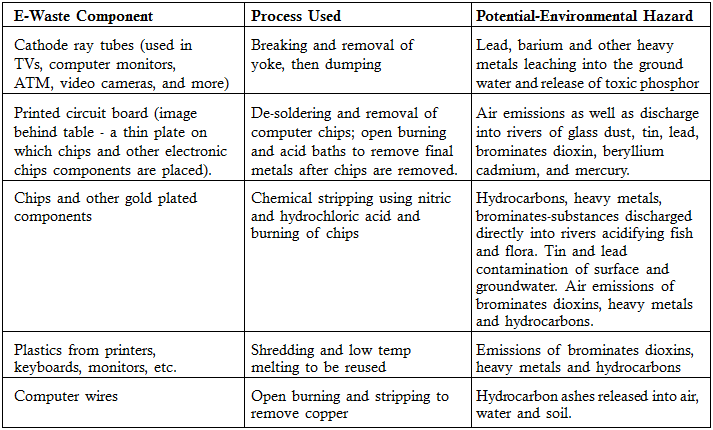
Impact of the solution
The proposed new approach to managing wastes will have a significant impact on the environment. Eliminating the irresponsible disposal of wastes will protect the environment and Chinese people from health hazards. The process may be involved in terms of time and resources needed, but the benefits are immense. It will promote the sustainable use of electronic products. The impact of electronic wastes is not only felt in China but also in a global context. Izatt (2016) explains that some of the electronic wastes end up in the ocean, which affects the marine ecosystem. The environmental impact of pollution affects all countries around the world.
Best alternative
Table 4 below identifies various e-waste disposal approaches that can be embraced. The waste management team can use landfills, incineration, pyrolysis, or recycle and reuse. Each of these methods would be suitable for different contexts. However, Little (2014) advises that recycle and reuse should always be given priority. It helps in protecting the environment.
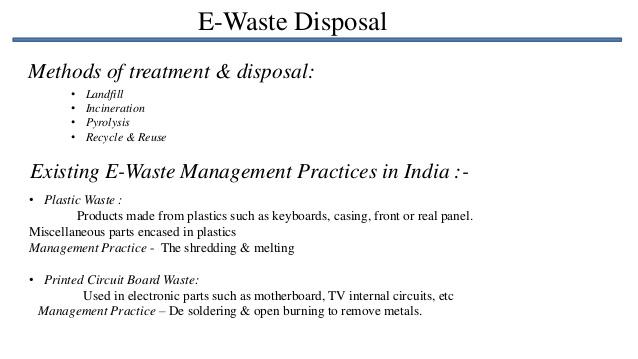
Measurement of success
The government, through the Ministry of Ecology and Environment and other environmental agencies, will need to have mechanisms of assessing the success of every new e-waste management plan. Iskyan (2016) suggests that the emissions rate is one of the measurement approaches that can be used. Electronic wastes, when irresponsibly disposed of, may emit specific gases that may pollute the air. The physical materials may also be harmful. Measuring the level of threat posed by these pollutants may help in determining the level of success achieved.
Conclusion
China is one of the largest economies in the world. It is also the leading nation in the consumption of electronic products because of the improved living standards and large population. Despite these achievements, the country faces a serious threat of a massive generation of electronic waste. Statistics show that China is the world’s leading producer of electronic waste. Unfortunately, the management of these dangerous waste substances is left in the hands of individuals within the informal sector who lack the appropriate skills of dealing with the challenges involved.
The government, through the Ministry of Ecology and Environment, local authorities, and various environmental agencies have made steps to promote responsible management of this form of waste. However, more still need to be done in this field. This study has recommended a new strategy that should be embraced, based on emerging technologies and best practices around the world that the country should embrace.
Reference List
Al-Habaibeh, A, Meyerowitz, A & Athresh, A 2015, ‘The design and development of an innovative simulator for an open loop system for extracting energy from flooded coal mines’, Energy Procedia, vol. 75, no. 1, pp. 1470-1476.
Amjad, U, Ojomo, E, Downs, E, Cronk, R & Bartram, J 2015, ‘Rethinking sustainability, scaling up, and enabling environment: a framework for their implementation in drinking water supply’, Water, vol. 7, no. 4, pp. 1497-1514.
Anttila, SL & Boffetta, P 2014, Occupational cancers, Springer, London.
Brinkmann, R 2016, Introduction to sustainability, John Wiley, Hoboken, NJ.
Brown, C, Lund, J, Ximing, C, Reed, P, Zagona, E, Ostfeld, A, Hall, J, Characklis, J, Gregory, W, Yu, W & Brekke, L 2015, ‘The future of water resources systems analysis: toward a scientific framework for sustainable water management’, Water Resources Research Journal, vol. 51, no. 8, pp. 6110-6124.
Gardner, DK 2018, Environmental pollution in China: what everyone needs to know, Oxford University Press, New York, NY.
Henkel, M 2015, 21st Century homestead: sustainable agriculture I, Wiley &Sons Publishes, Hoboken, NJ.
Iskyan, K, 2016, ‘China’s middle class is exploding’, Business Insider. Web.
Izatt, RM 2016, Metal sustainability: global challenges, consequences, and prospects, Wiley & Sons, Hoboken, NJ.
Khan, M & Chang, Y 2018, ‘Environmental challenges and current practices in China- a thorough analysis’ Sustainability, vol. 10, no. 7, p. 2547.
Little, PC 2014, Toxic town: IBM, pollution, and industrial risks, New York University Press, New York, NY.
Liu, H, Wu, X, Dou, D, Tang, X & Leong, K 2018, ‘Determining recycling fees and subsidies in China’s WEEE disposal fund with formal and informal sectors’, Sustainability, vol. 10, no. 2979, pp. 1-14.
McKinney, J 2017, Budgeting for sustainability, McFarland & Company Publishers, London.
Mmereki, D, Li, B, Baldwin, A & Hong, L 2016, ‘The generation, composition, collection, treatment and disposal system, and impact of e-waste’, IntechOpen, vol. 3, no. 1, pp. 66-84.
Namias, J 2013, ‘The future of electronic waste recycling in the United States: obstacles and domestic solutions’, PhD thesis, University of Columbia,New York, NY.
Qiu, W 2018, ‘There’s money in trash. Chinese companies are cashing in’, Bloomberg. Web.
Schaltegger, S 2014, Corporate sustainability in international comparison: state of practice, opportunities and challenges, Wiley & Sons, Hoboken, NJ.
Sternfeld, E (ed) 2017, Routledge handbook of environmental policy in China, Routledge, New York, NY.
Steven, C 2014, Understanding environmental policy, Columbia University Press, New York, NY.
Veit, HM & Moura Bernardes, A (eds) 2015, Electronic waste: recycling techniques, Springer, Cham.
Washburn, A 2013, The nature of urban design: a New York perspective on resilience, Wiley & Sons, Hoboken, NJ.
Williams, EF 2016, Green giants: how smart companies turn sustainability into billion-dollar businesses, Cengage, New York, NY.
Yamamoto, M & Hosoda, E (eds) 2016, The economics of waste management in East Asia, Routledge, London.